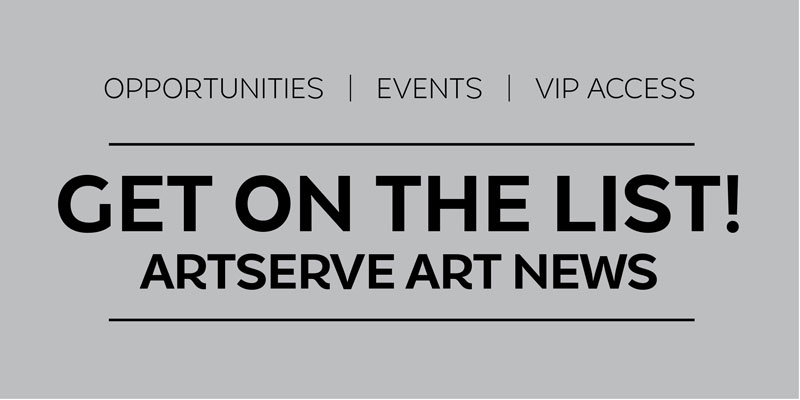
March 5, 2020 – April 15 2020
CONCLUDED EXHIBITION
(DIS)OBEDIENT- REDEFINING FEMINISM IN A FRACTURED REALITY
Curator
Sophie Bonet
guest curator: Carol-Anne McFarlane
Location
ArtServe
(DIS)OBEDIENT is the result of months-long investigations that lead to creative collaboration. This exhibition is a visual representation of what women are realizing our current fractured reality.
Curated by ArtServe Chief Curator Sophie Bonet and multidisciplinary artist and activist Carol-Anne McFarlane, (DIS)OBEDIENT explores the issue of gender inequality through visual and performing arts. (DIS)OBEDIENT offers commentary on topics ranging from wage disparities and exploitative advertising to underrepresentation in the art world and more.

Artist
Linda’s interest in shapes manifests itself through a variety of media, while seeking to bring forward the contradictions between the society’s expectations and an individual’s sense of self. Her focus is on women and the stark standards that have been established for a woman’s appearance. Linda believes you are what you create, as much as you are what you perform. Her goal is to create images that echo the past, confront the present, and embrace the future.
Fernanda’s work reflects every part of her, even the parts she is not fully aware of. She found a way to voice her thoughts, combining her photography and writing skills. Her personal experiences and pain have taught her the best cure is to communicate mostly with like-minded people. This connection keeps her motivated creating. Through her art, she calls attention to diversity in different shapes, ages, and ethnicities.
Her current work playfully hacks and manipulates existing imagery to chip away at façades, reinvent archetypes and create new mythologies, while investigating prescribed notions of gender, virtue, glamour, innocence, and power hierarchies that exist in contemporary culture.
In her series, she didn’t want to just illustrate strong women but also show characters representing girls with real issues in Asia and Africa, where they strive to make something of themselves despite the very fabric holding their community together works against them.
Melissa’s journey has led her on the continuous path of self-love and women’s empowerment. She has spent many years lacking confidence, not realizing she had the power to do something about it. A first visit to a nude beach in Greece was her “a-ha” moment that led her on a lifelong journey of cultivating self-love, acceptance and body positivity. She dove deep into herself uncovering and healing self-afflicted and ancestral wounds. Discovering artistic photography was one of the turning points in her life, sparking a shift that ignited her desire within to be a guiding light for other women to see their beauty inside and out and to reach their empowered state of being, and The Unleashed Project was conceived.
She has recently shown at Postmasters Gallery, Cindy Rucker Gallery, Practice Gallery, at the Brooklyn Bridge Park, at Roswell Museum and Art Center, at Matucana 100, Museo de Artes Visuales in Santiago, Chile, among many other venues.
In 2020 Bitran will be an artist in residence at Pioneer works NY and has previously held residencies at Skowhegan School of Painting and Sculpture, the Bemis Center for Contemporary Arts, the Roswell Artist-in-Residence Program, Smack Mellon Studio Program, and at outpost Projects. Bitran currently teaches in the Painting Departments at Pratt Institute and Rhode Island School of Design.
She has published critical writing in ART PAPERS, White-hot, Posture, Brooklyn Rail, hysteria, Bitch Magazine, Utne Reader and N.Paradoxa. Her work has been featured in Dazed, MILk, Interview, Japan Times, Huffington Post, ART 21, hyperallergic, PAPER, Art Fag City, Washington Post, and Art-Net TV among others. Cercone has curated shows for Momenta Art, kARST (Uk), Cue Art Foundation, Local Project and NurtureArt. Cercone is an adjunct faculty at the School of Visual Arts where she teaches GENDER TROUBLE in the Visual & Critical Studies Department.
Working in the field of arts since 2012, she has exhibited her works in fairs such as Scope Miami and Stroke Art Fair, as well as exhibitions in Brazil and Latin America, as well as in Portugal, Spain, and Germany, among others. Her work is in several public collections such as the Museo de Arte Contemporaneo de Bogota and the Museo Municipal de Arte Contemporaneo de Cusco, Peru.
Damali is a current Creative-In-Residence at Brooklyn Public Library. She is a recipient of the Queens Council on the Arts New Works Grant. She has been a fellow at Culture Push, the Robert Blackburn Printmaking Workshop, A.I.R. Gallery, and apexart in Seoul, South Korea.
Damali has also been an Artist-in-Residence at Fresh Milk in Barbados, Groundation Grenada, The Center for Book Arts, Jamaica Center for Arts & Learning (JCAL), and LMCC on Governors Island. Damali has presented her work at School of Visual Art (SVA), Sonoma State University, Soho house, UConn Stamford, Borough of Manhattan Community College (BMCC), Barbados Community College, New York University (NYU), SUNY Purchase, Hunter College School of Social Work, and Syracuse University’s 601 Tully.
Narcissister questions fetishism, particularly sexual fetishism, which is notorious in its fixing of racist and gendering stereotypes. Rather than abandon this contaminated site, Narcissister dives headlong into the muck, into the depths of the fantasy and fetish itself, to expose and deconstruct their power. Intervening in the exchange between the image and its psychic meaning uncovers the collective fantasies with which we invest these images, and forces representation open.
She believes in action towards social reconstruction and a world of self-examination leads to self–improvement, and empowerment.
She wants all of us to be more conscious of social manipulation and its long-term effects.
Carol-Anne McFarlane creates artwork that brings this consciousness to the forefront so people can be intentional when responding to what we experience in the world.
McFarlane has exhibited in Atlanta, Baltimore, New Orleans, New York, Des Plaines, Kansas City, London, and in various cities in South Florida. her writing was published in an issue of Girls Get Busy, a Uk zine about feminist artists. McFarlane’s work was in SELECT Art Fair in 2014 and in a segment of the Real Housewives of New York. McFarlane was a guest artist on ARTGirlTV in 2015. Recently, McFarlane was on a panel discussion about art and sexuality at the Beaver exhibition in New York, and in the Intersectionalityshow at the Museum of Contemporary Art in North Miami. The Self-Reflectionshow in New York, lead to McFarlane being covered in the Huffington Post and Vice. In October 2016, McFarlane was shown in the outer Space show in London, Uk.
McFarlane is in Beaver, the Exhibition curated by Naomi Ramirez. This collection of 20 artists is the fourth iteration of the Beaver Exhibition Event. A group exhibition that brings together artists who delve into feminist perspectives on pornography, gender performance, and female sexual self-expression through visual art is currently available for pre-order and ships in June 2020.
McFarlane was born in Fort Lauderdale, to Jamaican parents. She attended the Atlanta College of Art and graduated with a BFA in Illustration. She was a Resident Artist at the Lauderhill Arts Center for 6 years.
Marilyn first became involved in fighting child abuse in 1980. Despite no one talking about child abuse then, Marilyn and her friend rallied local women in St. Petersburg, FL to form an active group to address the topic. They named it Infinity The League to Aid Abused Children and Adults, Inc.
In 1983 her family moved to Fort Myers, FL. Some of her friends in Fort Myers encouraged her to start something similar there to continue the effort, and Concerned Citizens for Sexually Abused Children, Inc. was founded. They were a board of men and women in the community. They organized a puppet show which they took to pre-schools to enable children to open up about sexual abuse. Parents became more aware of their children’s activities as well as their interactions with strangers.









